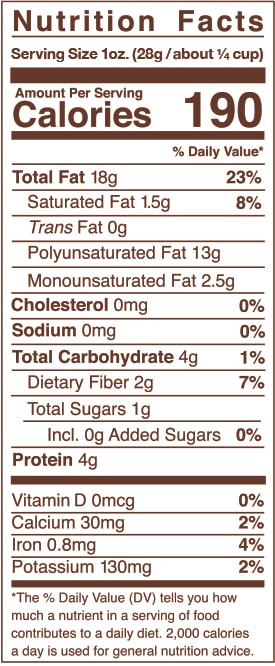
Sometimes it feels like you need to be a detective to figure out all the clues to help you make a healthy decision. But knowing how to interpret nutrition information on packages is a useful tool to make informed choices that align with your health goals. Here are some tips to help you navigate the nutrition facts label:
This is the amount of the food that is considered a single serving. The rest of the nutrition facts are based on that amount. For example, if the serving size says, “1oz.,” then the calories, fat, cholesterol, sodium, carbohydrates, protein, and other nutrients shown are for 1oz. of that food.
The number of calories in a food reflects the amount of energy your body gets from eating that food. The nutrition facts panel is based on a standard 2,000-calorie diet, which is a rough average of daily calorie intake for adults. To note, these values will differ for individual calorie needs. Remember: if the package contains more than one serving, the calories on the label must be multiplied by the number of servings you eat. For example, if a serving is 1/2 cup and you eat 1 cup, the calories will be the amount listed times two.
This is the total grams of all types of fat in one serving of the food. In a 2,000-calorie daily diet, most adults should aim for between 45 and 78 grams of total fat per day, mostly in the form of good, unsaturated fats from foods like heart-healthy1 walnuts, avocados, and extra virgin olive oil.2
Saturated fats are primarily found in animal products like meat and dairy but are present in some plant foods as well, like coconut oil. It is recommended to limit intake of these fats to less than 10% of daily calories, which is around 22 grams in a 2,000-calorie diet.2
Trans fats are naturally present in small quantities in certain foods like dairy and meat products and are also produced artificially in the form of partially hydrogenated oils. However, due to proven negative health effects, the addition of this type of fat has since been banned from the food supply.
Mono- and polyunsaturated fats are a key part of the diet and have been associated with a variety of health benefits. Replacing saturated fats with unsaturated fats is recommended to support heart heath. The omega-3 fatty acid in walnuts (2.5g/oz ALA) is one example of a type of polyunsaturated fat. It’s important to know which foods contain good fats such because not all labels will specifically list the mono- and polyunsaturated fat content. An easy tip to calculate it yourself is to subtract the amount of saturated fat from the total fat, and what is left is unsaturated.
Cholesterol is necessary for certain functions, but the body makes enough for these purposes, so does not need to be included in the diet. Though there is no longer a specific amount specified, it is recommended to limit consumption in a healthy eating pattern.2
Sodium is also a necessary nutrient for bodily processes, but average consumption far exceeds the recommendation and should generally be limited to less than 2,300 mg per day.2
Carbohydrates come in multiple forms from complex starches to simple sugars and are found in a variety of foods. Recommendations for intake differs by individual, but some examples of nutritious foods with carbohydrates include whole grains, dairy, fruits and vegetables.
Dietary fiber is a nutrient associated with benefits from gut health to heart health and is found in foods like whole fruits and vegetables, nuts, beans, legumes, and whole grains. Often lacking in the standard American diet, it is recommended that women consume around 25-28 grams and men consume 30-34 grams of fiber on a daily basis.2
Sugar is another form of carbohydrate found naturally in many foods like fruits and vegetables, as well as artificially in the form of sweeteners in packaged food products. While having sugar as an energy source in the diet is generally not a problem, it is now required to be included on the label and is recommended to limit added sugars to less than 50 grams per day. 2,3
Protein is found in an array of foods from both animal and plant-based products. A healthy eating pattern for most adults includes between 46-56 grams of protein per day from a variety of foods such as seafood, lean meat and poultry, eggs, nuts, seeds, legumes, and soy products.2
Nutrition facts are now required to include the amount of vitamin D, iron, calcium, and potassium in a food. This is because these micronutrients are essential for many functions in the body and may be missing in the American diet. Most people should aim to consume 100% of the daily recommended value in a healthy eating pattern.2
1 Supportive but not conclusive research shows that eating 1.5 ounces of walnuts per day, as part of a low saturated fat and low cholesterol diet, and not resulting in increased caloric intake may reduce the risk of coronary heart disease (FDA) One ounce of walnuts provides 18g of total fat, 2.5g of monounsaturated fat, 13g of polyunsaturated fat, including 2.5g of alph-linolenic acid, the plant-based omega-3 fatty acid.
2 U.S. Department of Agriculture and U.S. Department of Health and Human Services. Dietary Guidelines for Americans, 2020-2025. 9th Edition. December 2020. Available at DietaryGuidelines.gov.
3 U.S. Food & Drug Administration. The New and Improved Nutrition Facts Label – Key Changes. January 2018. Available at https://www.fda.gov/downloads/food/labelingnutrition/ucm511646.pdf.
